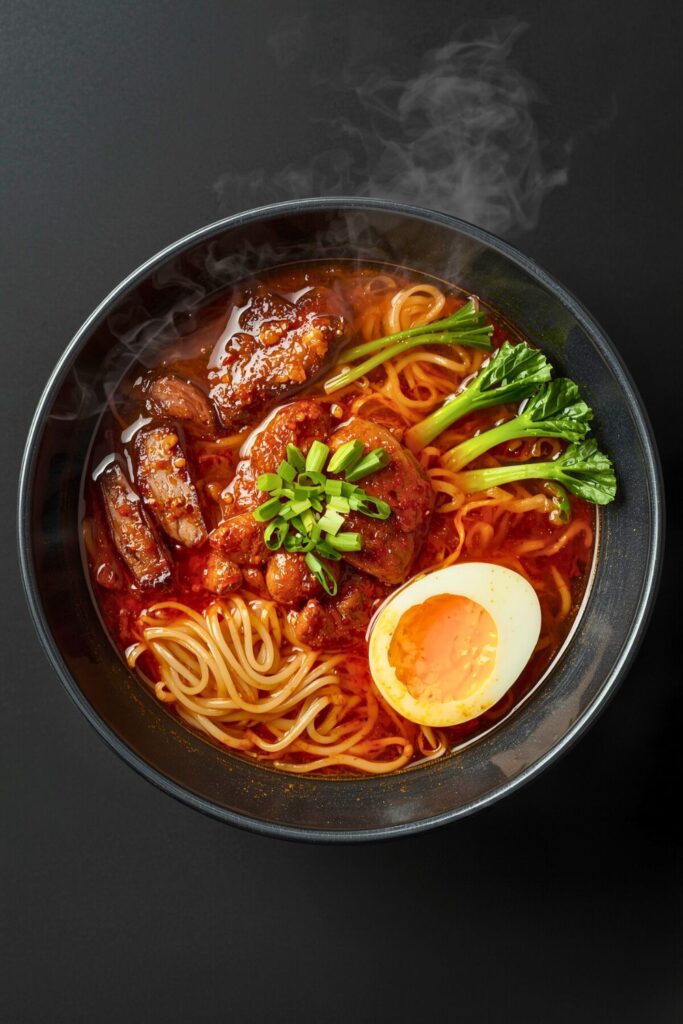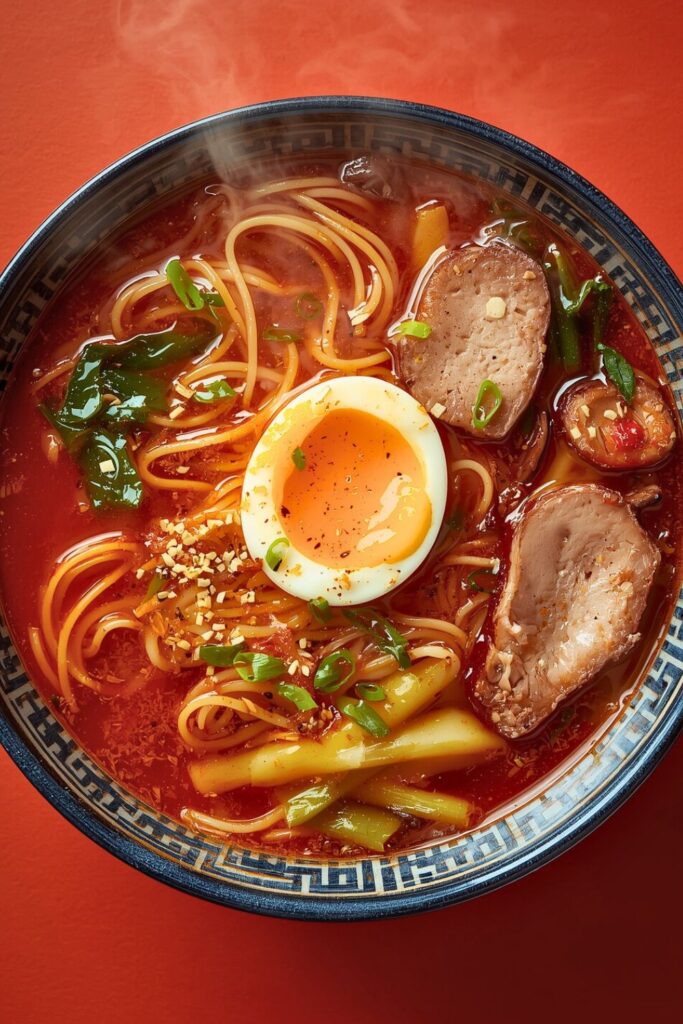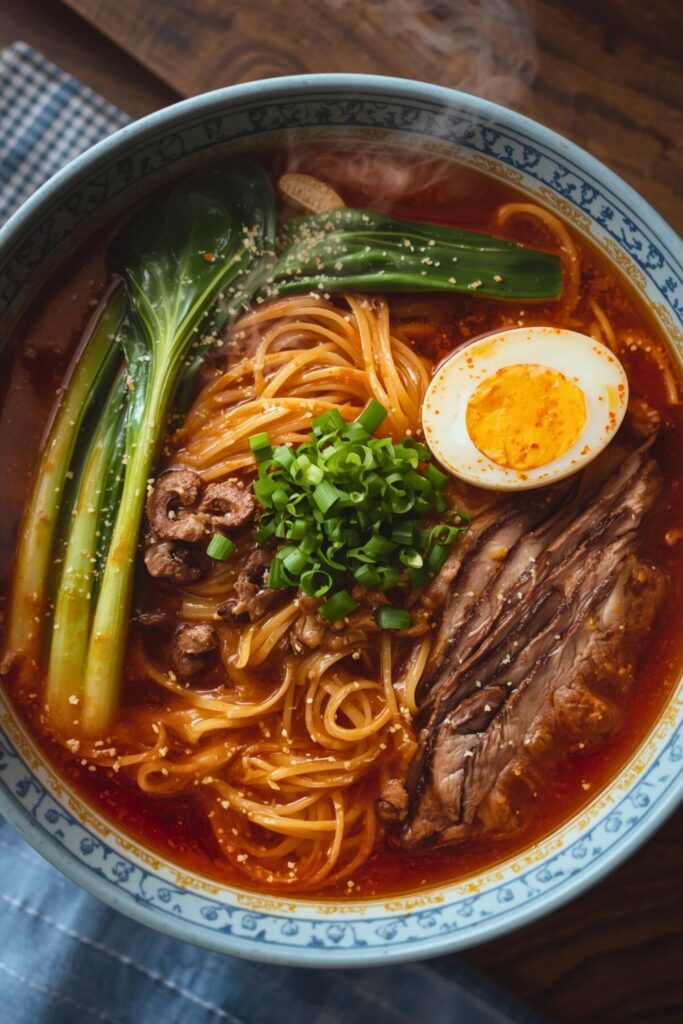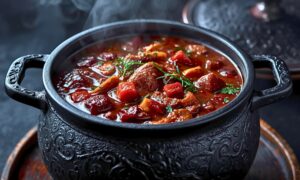There’s a reason some dishes never fade with time. You know that moment when the weather turns cold, or the day feels heavier than usual, and all you want is a bowl of something familiar, something that tastes like home? That’s when Spicy Korean Noodle Soup comes to the table.
For me, it’s more than just a quick recipe, it’s a memory. I can still hear the soft bubbling of broth in my mother’s kitchen, the way the air filled with garlic and chili, and the sight of steam curling up as noodles softened in the pot. Back then, it wasn’t about measuring or following a strict recipe. It was about gathering warmth in a bowl, using what was on hand, and letting spice chase away the chill.
The magic is in the little details: the earthy depth of gochujang melting into broth, the brightness of scallions scattered on top, the heat that lingers just enough to remind you you’re alive. Every spoonful carries both comfort and strength, quick to make, deeply satisfying, and timeless in its simplicity.
In this post, I’ll guide you through creating your own bowl of Spicy Korean Noodle Soup, step by step. From essential ingredients to easy variations, plus serving ideas that bring it to life, you’ll discover why this dish has been loved for generations. Trust me, once it’s on your table, it’ll feel like it’s always been part of your story.
Why This Spicy Korean Noodle Soup Changes Everything

Let me tell you something most recipe writers won’t admit: Korean noodle soups are forgiving as heck. They practically want you to succeed.
The beauty lies in how each ingredient builds on the others. Start with that gorgeous base of gochujang and you’ve already got 80% of your flavor profile locked in. Add some aromatics, build your broth, and watch magic happen. This isn’t some precious dish that falls apart if you breathe wrong, it’s robust, adaptable, and designed for home cooks.
Here’s what sets this particular spicy Korean noodle soup apart from watered down versions elsewhere. We’re building layers of heat, not just throwing in hot sauce and calling it a day. The spice comes from multiple sources, each contributing something different. Gochujang gives us fermented depth. Fresh chilies add bright heat. Kimchi juice brings funky complexity.
The noodles matter too. We’re not settling for whatever’s in the pantry. The right noodles make this dish sing, chewy, substantial, perfect for soaking up gorgeous broth.
Essential Spicy Korean Noodle Soup Ingredients
For the Broth Base:
- 8 cups chicken or vegetable stock (homemade’s best, good store bought works)
- 3 tablespoons gochujang (your flavor foundation, don’t skimp)
- 2 tablespoons soy sauce
- 1 tablespoon rice vinegar
- 1 teaspoon sesame oil
- 2 cloves garlic, minced
- 1-inch piece fresh ginger, grated
The Noodle Situation:
- 8 oz fresh or dried Korean wheat noodles (somyeon or ramyeon work beautifully)
- If you can’t find Korean noodles, thick udon or spaghetti work
The Supporting Cast:
- 1 cup napa cabbage kimchi, roughly chopped
- 2 green onions, sliced thin
- 1 soft boiled egg per bowl (trust me)
- 1 sheet nori, cut into strips
- 1 tablespoon kimchi juice (liquid gold)
- Toasted sesame seeds for garnish
Smart Swaps That Work:
Can’t find gochujang? Mix sriracha with miso paste and brown sugar. It’s not identical, but gets you close. No kimchi? Sauerkraut with rice vinegar adds fermented tang.
Vegetarian? Swap chicken stock for robust mushroom broth, shiitake and kombu make incredible base. The umami depth rivals any meat version.
Living somewhere without Asian ingredients? Most grocery stores carry basics now, but online ordering opens authentic options.
Here’s an insider secret about gochujang: brands vary wildly. Some are sweet, others pure fire. Taste yours first and adjust accordingly. Good gochujang has complexity beyond heat, fermented depth, subtle sweetness, real character.
The Step by Step Magic

Getting Your Mise Ready:
Start by getting everything prepped and within arm’s reach. This soup comes together quickly once you start, and you don’t wanna be frantically mincing garlic while your broth’s boiling over.
Soft boil those eggs first, they need time to cool before peeling. Six minutes in boiling water, straight into ice water, then peel when you’re ready to serve.
Building the Broth:
Heat a large pot over medium heat. Add just a touch of neutral oil, then toss in your minced garlic and grated ginger. Let them get fragrant, about 30 seconds, but don’t let them brown.
Now comes the crucial part. Add your gochujang and let it bloom in the oil for another 30 seconds. This step’s important, you’re awakening those fermented flavors, making them sing. Skip this and your soup tastes flat.
Slowly whisk in your stock. Start with a cup, whisking constantly to prevent the gochujang from clumping. Once smooth, add the rest of your stock, soy sauce, rice vinegar, and that splash of kimchi juice.
Bring everything to a gentle simmer. Not a rolling boil, that’ll make your broth cloudy and aggressive. We want a gentle, happy bubble.
The Noodle Dance:
Cook your noodles separately in salted water according to package directions. Here’s where most people mess up, they overcook the noodles thinking they’ll finish in the broth. Don’t do that. Cook them just until tender, drain, and rinse briefly with cool water to stop the cooking.
This prevents mushy noodles and keeps your broth clear. Professional move right there.
Assembly Time:
Divide your cooked noodles between bowls. Ladle that gorgeous, aromatic broth over them. Add your chopped kimchi, it’ll wilt slightly in the hot broth, releasing even more flavor.
Top each bowl with halved soft boiled eggs, sliced green onions, nori strips, and a generous sprinkle of sesame seeds. Drizzle with just a tiny bit of sesame oil.
The Science Behind the Sizzle
Here’s what’s really happening when you bloom that gochujang in oil: you’re activating the Maillard reaction. Those fermented soybeans and chilies contain proteins and sugars that develop incredible complexity when heated. Skip this step and you miss out on layers of flavor.
The vinegar isn’t just for tang, it brightens the entire soup, cutting through the richness and making every other flavor pop. It’s like turning up the contrast on a photo.
Kimchi juice is pure liquid umami. It’s already fermented, loaded with beneficial bacteria and intense flavor. Adding it to your broth is like having a secret ingredient that most restaurants won’t tell you about.
The soft boiled egg isn’t just pretty, it adds richness and helps mellow the heat. As you eat, the creamy yolk mixes with the broth, creating this gorgeous, silky texture.
Temperature matters too. Serving this soup properly hot ensures the aromatics hit you first, that’s half the eating experience. Cold soup doesn’t release those volatile compounds that make your mouth water.
Making It Instagram Worthy
Presentation’s easier than you think. Use deep bowls, the soup should look abundant, not sparse. Arrange your toppings thoughtfully, egg halves cut side up, green onions scattered naturally, not lined up like little soldiers.
The color contrast is naturally gorgeous, that rich red broth against white noodles, green scallions, and the golden egg yolk. Don’t overthink it.
For photos, natural light’s your friend. The steam rising from hot soup creates amazing atmosphere in pictures. Shoot from slightly above and capture that steam if you can.
Perfect Pairings:
This soup wants simple sides that won’t compete. Korean pickled radish cuts through the richness beautifully. Crispy seaweed snacks add textural contrast. A small portion of steamed rice lets people customize their spice level.
For drinks, cold beer’s classic for a reason, it cools the heat and complements the fermented flavors. Green tea works too, especially if you’re eating this as a light meal.
Make Ahead Magic:
The broth actually improves overnight as flavors meld. Make a big batch, store it in the fridge, and reheat as needed. Cook noodles fresh each time though, reheated noodles get mushy and sad.
Portion the broth into containers with pre prepped toppings. Fifteen minutes from fridge to bowl for weeknight dinners.
Mastering the Perfect Spicy Korean Noodle Soup Heat Level
Getting the spice level right is an art form. Start conservatively with the gochujang, you can always add more, but you can’t take it back.
Taste your broth before adding noodles. It should have a gentle heat that builds gradually, not a immediate slap of fire. If it’s too spicy, add a splash more stock or a tiny bit of sugar to balance things out.
Different brands of gochujang have wildly different heat levels. Some Korean brands are mild and sweet, others will clear your sinuses. Know your ingredient.
The kimchi adds another layer of heat, but it’s different, more fermented and complex than straight chili heat. If your kimchi’s particularly fiery, use less and balance with more regular cabbage.
Here’s a pro tip: keep some plain cooked rice on standby. If someone’s struggling with the heat, a spoonful of rice mixed into the soup mellows everything beautifully without diluting flavors.
Troubleshooting When Things Go Sideways

Broth too salty? Add a splash of water and a tiny bit of sugar. The sugar balances the salt better than just diluting.
Not spicy enough? Whisk in more gochujang, but thin it with a bit of hot broth first so it incorporates smoothly.
Gochujang clumped up? Strain the broth and whisk the gochujang with some of the hot liquid until smooth, then add back.
Noodles got mushy? Happens to the best of us. Cook fresh ones, it takes five minutes and makes all the difference.
The beauty of this soup is its forgiveness. Even if something goes a bit wrong, it’s usually still delicious. That’s the magic of Korean comfort food.
This spicy Korean noodle soup isn’t just a recipe, it’s your ticket to understanding how Korean flavors work together. Master this bowl and you’ll start seeing how gochujang, kimchi, and these techniques apply to dozens of other dishes.
Make it once, and I guarantee you’ll be craving it again within the week. It’s that kind of soup, the kind that gets under your skin and makes you realize what you’ve been missing. Your taste buds deserve this level of excitement.
Frequently Asked Questions
Can I make this soup vegetarian or vegan?
Absolutely! Swap the chicken stock for a rich mushroom or vegetable broth, I love using shiitake and kombu for that deep umami flavor. Skip the egg or use a marinated tofu alternative. The soup’s actually incredible this way and doesn’t feel like it’s missing anything.
How spicy is this really, and can I tone it down?
It’s got a medium high heat that builds as you eat. Start with 2 tablespoons of gochujang instead of 3, and you can always add more. The kimchi adds heat too, so use less if you’re heat sensitive. A dollop of sour cream or extra egg yolk cools things down without ruining the flavor profile.
What if I can’t find Korean noodles anywhere?
Don’t stress about it! Thick udon noodles work beautifully, and honestly, even spaghetti can work in a pinch. The key is using something with good chew that won’t fall apart in hot broth. Fresh ramen noodles from the refrigerated section are another solid backup.
How long will the broth keep, and can I freeze it?
The broth gets better after a day or two in the fridge, all those flavors really meld together. It’ll keep for about a week refrigerated. You can totally freeze it for up to three months, though the texture might change slightly. Always cook noodles fresh though, they get weird when reheated.
Is this soup actually healthy, or just comfort food?
It’s both! You’re getting probiotics from the kimchi, plenty of vegetables, and if you go easy on the sodium, it’s actually pretty nutritious. The fermented ingredients are great for gut health. Add extra vegetables, use whole grain noodles, or serve smaller portions with a side salad to make it even healthier without sacrificing flavor.

Swiftly Captions by Tina Smith — Quick, flavorful food recipes made simple, bringing fresh inspiration to your kitchen every day






